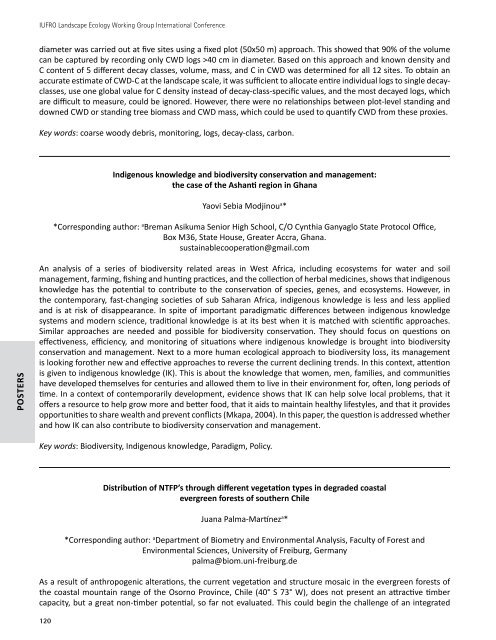IUFRO-LIBRO
IUFRO-LIBRO
IUFRO-LIBRO
Create successful ePaper yourself
Turn your PDF publications into a flip-book with our unique Google optimized e-Paper software.
Posters<br />
<strong>IUFRO</strong> Landscape Ecology Working Group International Conference<br />
diameter was carried out at five sites using a fixed plot (50x50 m) approach. This showed that 90% of the volume<br />
can be captured by recording only CWD logs >40 cm in diameter. Based on this approach and known density and<br />
C content of 5 different decay classes, volume, mass, and C in CWD was determined for all 12 sites. To obtain an<br />
accurate estimate of CWD‐C at the landscape scale, it was sufficient to allocate entire individual logs to single decay‐<br />
classes, use one global value for C density instead of decay‐class‐specific values, and the most decayed logs, which<br />
are difficult to measure, could be ignored. However, there were no relationships between plot‐level standing and<br />
downed CWD or standing tree biomass and CWD mass, which could be used to quantify CWD from these proxies.<br />
Key words: coarse woody debris, monitoring, logs, decay‐class, carbon.<br />
120<br />
Indigenous knowledge and biodiversity conservation and management:<br />
the case of the Ashanti region in Ghana<br />
Yaovi Sebia Modjinou a *<br />
*Corresponding author: a Breman Asikuma Senior High School, C/O Cynthia Ganyaglo State Protocol Office,<br />
Box M36, State House, Greater Accra, Ghana.<br />
sustainablecooperation@gmail.com<br />
An analysis of a series of biodiversity related areas in West Africa, including ecosystems for water and soil<br />
management, farming, fishing and hunting practices, and the collection of herbal medicines, shows that indigenous<br />
knowledge has the potential to contribute to the conservation of species, genes, and ecosystems. However, in<br />
the contemporary, fast‐changing societies of sub Saharan Africa, indigenous knowledge is less and less applied<br />
and is at risk of disappearance. In spite of important paradigmatic differences between indigenous knowledge<br />
systems and modern science, traditional knowledge is at its best when it is matched with scientific approaches.<br />
Similar approaches are needed and possible for biodiversity conservation. They should focus on questions on<br />
effectiveness, efficiency, and monitoring of situations where indigenous knowledge is brought into biodiversity<br />
conservation and management. Next to a more human ecological approach to biodiversity loss, its management<br />
is looking forother new and effective approaches to reverse the current declining trends. In this context, attention<br />
is given to indigenous knowledge (IK). This is about the knowledge that women, men, families, and communities<br />
have developed themselves for centuries and allowed them to live in their environment for, often, long periods of<br />
time. In a context of contemporarily development, evidence shows that IK can help solve local problems, that it<br />
offers a resource to help grow more and better food, that it aids to maintain healthy lifestyles, and that it provides<br />
opportunities to share wealth and prevent conflicts (Mkapa, 2004). In this paper, the question is addressed whether<br />
and how IK can also contribute to biodiversity conservation and management.<br />
Key words: Biodiversity, Indigenous knowledge, Paradigm, Policy.<br />
Distribution of nTFP’s through different vegetation types in degraded coastal<br />
evergreen forests of southern Chile<br />
Juana Palma‐Martínez a *<br />
*Corresponding author: a Department of Biometry and Environmental Analysis, Faculty of Forest and<br />
Environmental Sciences, University of Freiburg, Germany<br />
palma@biom.uni‐freiburg.de<br />
As a result of anthropogenic alterations, the current vegetation and structure mosaic in the evergreen forests of<br />
the coastal mountain range of the Osorno Province, Chile (40° S 73° W), does not present an attractive timber<br />
capacity, but a great non‐timber potential, so far not evaluated. This could begin the challenge of an integrated


